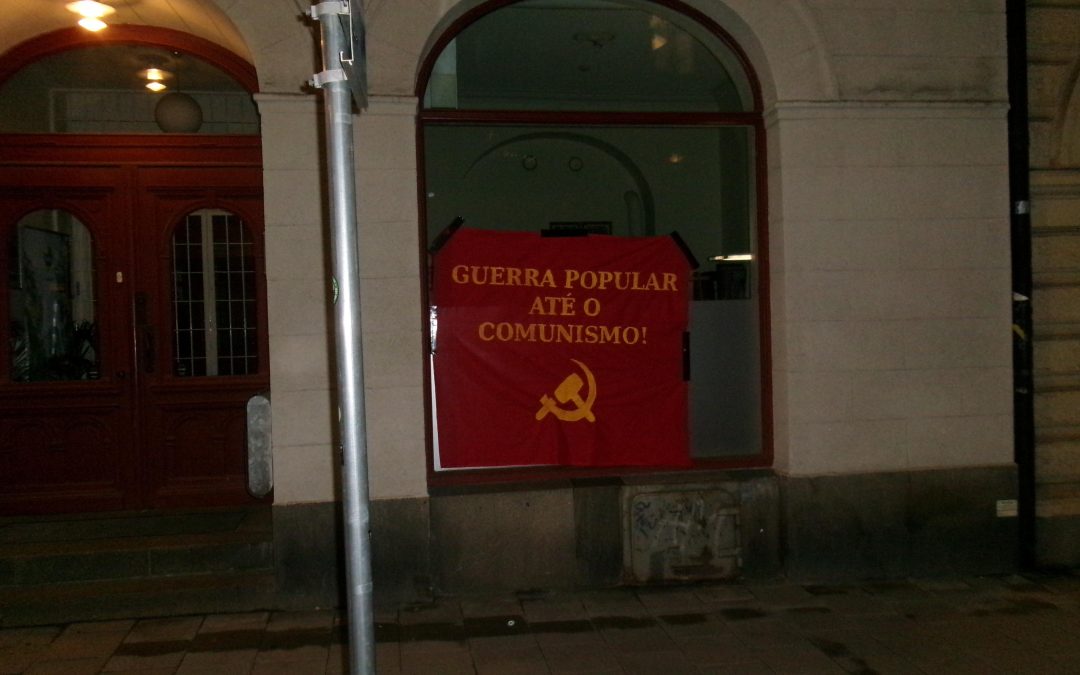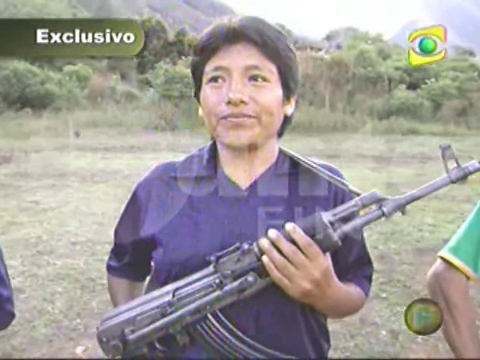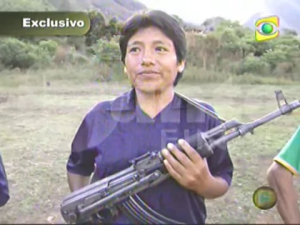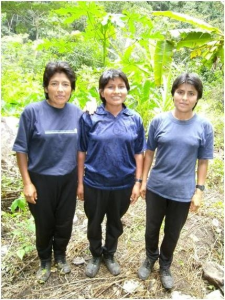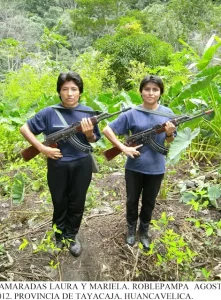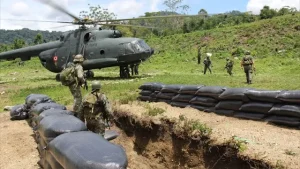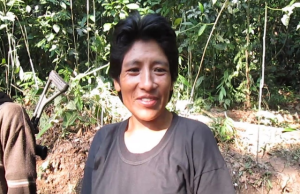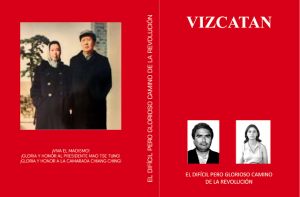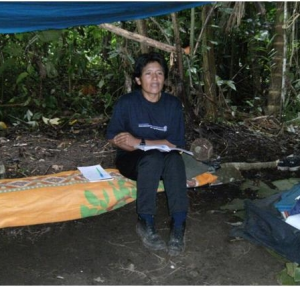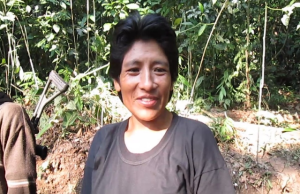DOCUMENTOS FUNDAMENTALES
¡Proletarios de todos los países, uníos!
DOCUMENTOS FUNDAMENTALES
Comité Central
Partido Comunista del Perú
1988
DOCUMENTOS FUNDAMENTALES
I. SOBRE EL MARXISMO-LENINISMO-MAOISMO.
La ideología del proletariado internacional, en el crisol de la lucha de clases, insurgió como marxismo deviniendo marxismo-leninismo y, posteriormente, marxismo-leninismo-maoísmo. Así, la todopoderosa ideología científica del proletariado, todopoderosa porque es verdadera, tiene tres etapas: 1) marxismo, 2) leninismo, 3) maoísmo; tres etapas, momentos o hitos de su proceso dialéctico de desarrollo; de una misma unidad que en ciento cuarenta años, a partir del “Manifiesto”, en la más heroica epopeya de la lucha de clases, en encarnizadas y fructíferas luchas de dos líneas en los propios partidos comunistas y la inmensa labor de titanes del pensamiento y la acción que solamente la clase podía generar, sobresaliendo tres luminarias inmarcesibles: Marx, Lenin, Mao Tse-tung, mediante grandes saltos y tres grandiosos nos ha armado con el invencible marxismo-leninismo-maoísmo, principalmente maoísmo de hoy.
Sin embargo, mientras el marxismo-leninismo logró reconocimiento de su validez universal, el maoísmo no es reconocido plenamente como tercera etapa; pues, mientras unos niegan simplemente su condición de tal, otros sólo llegan a su aceptación como “pensamiento Mao Tsetung”. Y, en esencia, en ambos casos, con las obvias diferencias que entre sí tienen, niegan el desarrollo general del marxismo hecho por el Presidente Mao Tsetung; no reconocerle su carácter de “ismo”, de maoísmo, es negarle vigencia universal y, en consecuencia, su condición de tercera, nueva y superior etapa de la ideología del proletariado internacional: el marxismo-leninismo-maoísmo, principalmente maoísmo que enarbolamos, defendemos y aplicamos.
Como INTRODUCCION para mejor comprender el maoísmo y la necesidad de luchar por él, recordemos a Lenin. Nos enseñó que conforme la revolución se adentraba al Este expresaba condiciones específicas que, si bien no negaban principios o leyes, eran nuevas situaciones que el marxismo no podía ignorar so pena de exponer la revolución al fracaso. Y que pese a la grita que particularmente la intelectualidad atiborrada de liberalismo y falsamente marxista, pedante y libresca, levantara en contra de lo nuevo, lo único justo y correcto es aplicar el marxismo a la realidad concreta y resolver las nuevas situaciones y problemas que toda revolución necesariamente enfrenta y resuelve; ante el espanto y farisaicas “defensas de la ideología, de la clase y del pueblo” que proclaman revisionistas, oportunistas y renegados, o los furibundos y ciegos ataques de embrutecidos académicos y plumíferos del viejo orden, envilecidos de podrida ideología burguesa, dispuestos a defender la vieja sociedad que parasitan. Más aún, expresamente Lenin dijo que la revolución en Oriente depararía nuevas y grandes sorpresas para mayor asombro de los adoradores de seguir sólo los caminos conocidos e incapaces de ver lo nuevo; y, como todos sabemos, encomendó a los camaradas orientales resolver problemas que aún el marxismo no había resuelto.
Además, tener muy presente que cuando el camarada Stalin justa y correctamente planteó que habíamos entrado a la etapa del leninismo como desarrollo del marxismo, también hubo oposición y quienes rasgaron sus vestiduras en supuesta defensa del marxismo; tener muy presente que, también del leninismo hubo quienes dijeron que solamente era aplicable a los países atrasados; pero en medio de lucha la práctica lo consagró como gran desarrollo del marxismo y la ideología del proletariado brilló victoriosa ante el mundo como marxismo-leninismo.
Hoy, el maoísmo enfrenta situaciones similares; y como siempre lo nuevo y el marxismo se han abierto paso a través de la lucha, el maoísmo así también se impondrá y será reconocido.
En cuanto al CONTEXTO en que se desenvolvió el Presidente Mao Tsetung y se forjó el maoísmo, internacionalmente sobre la base del imperialismo, guerras mundiales, movimiento proletario internacional, movimiento de liberación nacional, lucha entre marxismo y revisionismo y restauración del capitalismo en la URSS, tres grandes hitos históricos cabe destacar en el presente siglo: primero, la revolución de Octubre, 1917, que abre la era de la revolución proletaria mundial; segundo, triunfo de la revolución china, 1949, cambiando la correlación de fuerzas a favor del socialismo; y tercero, gran revolución cultural proletaria, iniciada el 66, como continuación de la revolución bajo la dictadura del proletariado para mantener el rumbo hacia el comunismo. Baste resaltar que el Presidente Mao dirigió dos de estos gloriosos hechos históricos.
Y en China, donde como centro de la revolución mundial se concretó el maoísmo, dentro de la más compleja convergencia de contradicciones, intensa y cruenta lucha de clases signada por las pretensiones de las potencias imperialistas de despedazar y repartirse China, el derrumbe del imperio manchú (1911), el movimiento antiimperialista del 19, las rebeliones del inmenso campesinado, los veintidós años de lucha armada de la revolución democrática, la gran contienda por la construcción y desarrollo del socialismo y los diez años de tormenta revolucionaria por llevar adelante la revolución cultural, en medio de la más aguda lucha de dos líneas en el P.C.Ch especialmente contra el revisionismo, y todo enmarcado en el panorama internacional descrito. Es de este conjunto de hechos históricos que debemos extraer cuatro de extraordinaria importancia: la fundación del Partido Comunista de China en 1921; el Levantamiento de la Cosecha de Otoño iniciando el camino del campo a la ciudad, en 1927; la fundación de la República Popular, 1949; y la Gran Revolución Cultural Proletaria, 1966-76; en todos los cuales el Presidente Mao fue protagonista y principalmente el más alto dirigente como jefe reconocido de la revolución china.
Así de la biografía del Presidente Mao Tsetung podemos decir que, nacido el 26 de diciembre de 1893, abrió los ojos en un mundo agitado por las llamas de la guerra; hijo de campesinos tenía siete años cuando la “Guerra de los boxers”; estudiante para maestro estaba por los dieciocho cuando se derrumbó el imperio, se alistó como soldado para después ser gran organizador de campesinos y jóvenes, en Junán su tierra natal. Fundador del Partido Comunista y del Ejército Rojo de obreros y campesinos; estableció el camino de cercar las ciudades desde el campo, desarrolló la guerra popular y con ella la teoría militar del proletariado; teórico de la Nueva Democracia fundó la República Popular; gestor del Gran Salto Adelante e impulsor del desarrollo del socialismo; guía de la lucha contra el revisionismo contemporáneo de Jruschov y sus secuaces, jefe y mando de la Gran Revolución Cultural Proletaria. Estos son hitos que jalonan una vida dedicada cabal y plenamente a la revolución. Tres gigantescos triunfos tiene el proletariado en este siglo; dos corresponden al Presidente Mao y si uno es suficiente gloria, dos lo son más.
Sobre el CONTENIDO del maoísmo, obviamente lo sustancial del mismo, debemos apuntar a las cuestiones básicas siguientes:
1. Teoría. El marxismo tiene tres partes: filosofía marxista, economía política marxista y socialismo científico; el desarrollo en todas ellas que genere un gran salto cualitativo del marxismo en su conjunto, como unidad a un nivel superior implica una nueva etapa. En consecuencia, lo esencial es mostrar que el Presidente Mao ha generado, como puede verse en la teoría y en la práctica, tal gran salto cualitativo. Por necesidad expositiva veamos ésto en el presente y siguientes puntos.
En la filosofía marxista desarrolló lo medular de la dialéctica, la ley de la contradicción estableciéndola como única ley fundamental; y aparte de su profunda comprensión dialéctica de la teoría del conocimiento, cuyo centro son los dos saltos que conforman su ley, (de la práctica al conocimiento y de éste a aquélla, siendo principal el del conocimiento a la práctica), resaltar que aplicó magistralmente la ley de la contradicción a la política; y más aún llevó la filosofía a las masas cumpliendo la tarea que Marx dejara.
En economía política marxista. El presidente Mao aplicó la dialéctica para analizar la relación base-superestructura y prosiguiendo la lucha del marxismo-leninismo contra la tesis revisionista de las “fuerzas productivas”, concluyó que la superestructura, la conciencia pueden modificar la base y con el poder político desarrollar las fuerzas productivas. Y desarrollando la idea leninista de la política como expresión concentrada de la economía, estableció la política es el mando, (aplicable en todos los planos) y el trabajo político es la línea vital del trabajo económico; lo cual lleva a un verdadero manejo de la economía política y no a una simple política económica.
Una cuestión que se soslaya, no obstante su importancia, especialmente para quienes enfrentan revoluciones democráticas, es la tesis maoísta del capitalismo burocrático; esto es, el capitalismo que se desenvuelve en las naciones oprimidas por el imperialismo y con diverso grado de feudalidad subyacente u otras anteriores incluso. Este es un problema vital principalmente para Asia, Africa y América Latina, pues, de su comprensión deriva una buena conducción revolucionaria, máxime si de la confiscación del mismo depende, económicamente, la base para llevar adelante la revolución socialista como segunda etapa.
Pero, lo principal es que el Presidente Mao Tsetung ha desarrollado la economía política del socialismo. Es de suma importancia su crítica a la construcción socialista en la URSS; asimismo sus tesis sobre cómo desenvolver el socialismo en China: tomar la agricultura como base y la industria como dirigente; la industrialización guiándose por la relación entre la industria pesada, la ligera y la agricultura, tomando como centro de la construcción económica a la industria pesada y simultáneamente prestar plena atención a la industria ligera como a la agricultura. Cabe destacar el Gran Salto Adelante y las condiciones para su ejecución: uno, línea política que le dé justo y correcto rumbo; dos, formas orgánicas pequeñas, medianas y grandes de mayor a menor cantidad respectivamente; tres, un gran impulso, un gigantesco esfuerzo de las masas para ponerlo en marcha y llevarlo al éxito; salto adelante cuyos resultados se aprecian más por el proceso puesto en movimiento y su perspectiva histórica que por sus logros inmediatos; y su ligazón con la cooperativización agrícola y la comuna popular. Finalmente, tener muy en cuenta sus enseñanzas sobre la objetividad y subjetividad en la comprensión y manejo de las leyes del socialismo; que las pocas décadas de socialismo no han permitido ver su pleno desarrollo y por tanto el mejor conocimiento de sus leyes y su especificación; y principalmente la relación entre revolución y proceso económico, concretada en “empeñarse en la revolución y promover la producción”. Sin embargo, pese a su trascendental importancia poco se trata este desarrollo de la economía política marxista.
En el socialismo científico el Presidente Mao desarrolló la teoría de las clases analizándolas en los planos económico, político e ideológico; la violencia revolucionaria como ley universal sin excepción alguna; la revolución como sustitución violenta de una clase por otra, estableció su gran tesis “El Poder nace del fusil” y resolvió la cuestión de la conquista del Poder en las naciones oprimidas a través del camino de cercar las ciudades desde el campo, estatuyendo sus leyes generales. Definió brillantemente desarrollándola la teoría de la lucha de clases en el socialismo, que en él prosigue la lucha antagónica entre proletariado y burguesía, entre camino socialista y capitalista y entre socialismo y capitalismo; que concretamente no estaba definido quién vencería a quién, problema cuya solución demandaría tiempo, el desenvolvimiento del proceso de restauración y contrarrestauración para que el proletariado se afincara definitivamente en el Poder mediante la dictadura del proletariado; y final y principalmente la grandiosa solución de trascendencia histórica de la Gran Revolución Cultural Proletaria como continuación de la revolución socialista bajo la dictadura del proletariado.
Estas cuestiones básicas, casi simplemente enunciadas pero conocidas e innegables, muestran el desarrollo del Presidente de las partes integrantes del marxismo y la evidente elevación del marxismo-leninismo a una nueva, tercera y superior etapa: el marxismo-leninismo-maoísmo, principalmente maoísmo.
Prosiguiendo esta visión sintética, veamos otros puntos específicos que si bien derivan de lo anterior deben considerarse, aunque sea enumerativamente, para por lo menos destacarlos llamando la atención sobre ellos.
2. La Nueva Democracia. Primeramente es un desarrollo de la teoría marxista del Estado el establecimiento de los tres tipos de dictadura: 1) de la burguesía, en las viejas democracias burguesas como Estados Unidos, tipo al cual es asimilable la dictadura existente en las naciones oprimidas como las latinoamericanas; 2) la dictadura del proletariado como en la Unión Soviética o China antes de la usurpación del Poder por los revisionistas; y 3) la Nueva Democracia como dictadura conjunta basada en la alianza obrero-campesina dirigida por el proletariado encabezado por el Partido Comunista, lo que en China se plasmara a lo largo de su revolución democrática y en el Perú se concreta hoy en comités populares, bases de apoyo y República Popular de Nueva Democracia en organización. Es fundamental resaltar, dentro de este desarrollo de la teoría del Estado, la diferenciación clave entre sistema de Estado como dictadura de la clase o clases que ejercen el Poder, que es lo principal, y sistema de gobierno entendida como organización para el ejercicio del Poder.
Por otro lado, la Nueva Democracia, uno de los extraordinarios desarrollos del Presidente Mao, nos concreta magistralmente la revolución burguesa de nuevo tipo la que sólo puede dirigir el proletariado, en síntesis la revolución democrática dentro de la nueva era de la revolución proletaria mundial en que nos desenvolvemos. Revolución de Nueva Democracia que implica nueva economía, nueva política y nueva cultura, obviamente derrumbando el viejo orden y levantando lo nuevo con fusiles, única forma de transformar el mundo.
Finalmente, es importante resaltar que la Nueva Democracia, como revolución democrática si bien cumple, principalmente, las tareas democráticas también, complementariamente, avanza en algunas tareas socialistas; de esta forma se resuelve a fondo la cuestión de las dos etapas, democrática y socialista, que corresponden a países como el nuestro garantizándose, concluída la democrática, la prosecución como revolución socialista sin intermedio alguno, ininterrumpidamente.
3. Los tres instrumentos. El problema de la construcción de los instrumentos de la revolución plantea al Partido la comprensión de la interrelación del Partido, el ejército y el frente único; y, comprender y manejar la construcción interrelacionada de los tres en medio de la guerra o en el mantenimiento del nuevo Estado basado en el poderío del pueblo armado expresa una justa y correcta labor de dirección. La construcción se guía por principio de la justa y correcta línea ideológica lo decide todo, y es sobre esta base ideológico-política que simultáneamente se desarrolla la construcción organizativa, en medio de la lucha entre la línea proletaria y la burguesa y en la tempestad de la lucha de clases, principalmente de la guerra, como forma principal de lucha ya sea actuante o potencial.
En cuanto al Partido, el Presidente Mao parte de la necesidad del Partido Comunista, de un partido de nuevo tipo, un partido del proletariado, hoy diríamos un partido marxista-leninista-maoísta; un partido cuyo objetivo es conquistar el Poder y defenderlo, por lo cual está indesligablemente ligado a la guerra popular, ya sea para iniciarla, desarrollarla o librarla para defenderse; un partido sustentando en las masas ya sea por la propia guerra popular que es guerra de masas o del frente único que siendo frente de clases se basa en las masas mayoritarias. El Partido se desarrolla y cambia según las etapas de la revolución y los períodos que aquellas tengan; y el motor de su desarrollo es la contradicción concretada en su seno como lucha de dos líneas, entre línea proletaria y línea burguesa o no proletaria en general, en esencia y principalmente una lucha contra el revisionismo. Esto lleva a la importancia decisiva de la ideología en la vida partidaria y al desarrollo de campañas de rectificación que sirvan al mayor ajuste de todo el sistema de organizaciones partidarias y la militancia a las líneas ideológicas y políticas justas y correctas, en función del predominio de la línea proletaria y el mantenimiento de la dirección partidaria en sus férreas manos. El Partido sirve al establecimiento del Poder del proletariado, ya sea como clase dirigente de la Nueva Democracia y principalmente a la instauración de la dictadura del proletariado, su fortalecimiento y desarrollo para mediante revoluciones culturales conquistar la gran meta final, el comunismo; por eso el Partido tiene que llegar a dirigir todo omnímodamente.
El ejército revolucionario es de nuevo tipo, esto es un ejército para el cumplimiento de las tareas políticas que el Partido establece en función de los intereses del proletariado y del pueblo; carácter que se concreta en tres tareas: combatir, producir para no ser carga parasitaria y movilizar a las masas. Es un ejército que se basa en la construcción política a partir de la ideología del proletariado, del marxismo-leninismo-maoísmo (hoy), y la línea política general cuanto militar que el Partido establezca. Es un ejército que se basa en los hombres y no en las armas; un ejército surgido de las masas y siempre ligado a ellas a quienes sirve de todo corazón, permitiéndole moverse en su seno como el pez en el agua. Sin un ejército popular nada tendrá el pueblo, dice el Presidente Mao a la vez que nos enseña la necesidad de la dirección absoluta del Partido sobre el ejército y sienta su gran principio: El Partido manda al fusil y jamás permitiremos lo contrario. Además de establecer cabalmente los principios y normas de la construcción de un ejército de nuevo tipo, el mismo Presidente llamó a conjurar el uso del ejército para la restauración capitalista usurpando la dirección mediante un golpe contrarrevolucionario, y desarrollando tesis de Lenin sobre la milicia popular llevó más adelante que nadie el armamento general del pueblo, abriendo trocha y señalando el camino hacia el mar armado de masas que nos guiará a la -emancipación definitiva del pueblo y del proletariado.
Es el Presidente Mao Tsetung quien por vez primera desarrolla una teoría completa sobre el frente único y establece sus leyes. Un frente basado en la alianza obrero-campesina como garantía de la hegemonía del proletariado en la revolución; un frente de clases dirigido por el proletariado representado por el Partido; en síntesis un frente único bajo dirección del Partido Comunista; un frente único para la guerra popular, para la revolución, para la conquista del Poder en beneficio del proletariado y el pueblo. Así, en concreto, el frente único es la agrupación de las fuerzas revolucionarias contra las fuerzas contrarrevolucionarias para librar la lucha entre revolución y contrarrevolución principalmente mediante la guerra popular, armadamente. El frente único, como es evidente, no es igual en cada etapa de la revolución y, más aún, tiene sus especificaciones según los diversos períodos de cada etapa; asimismo el frente único en una revolución concreta no es igual que a nivel mundial, aunque ambos sigan las mismas leyes generales. Aparte de esto, es importante resaltar la relación entre frente y Estado que el Presidente Mao establece planteando que el frente único es una forma de dictadura conjunta, cuando se desenvolvía la guerra antijaponesa, cuestión que merece estudiarse especialmente por quienes afrontamos revoluciones democráticas.
4. La guerra popular es la teoría militar del proletariado internacional; en ella se resume, por vez primera en forma sistemática y completa, la experiencia teórica y práctica de las luchas, acciones militares y guerras libradas por el proletariado y la larga experiencia de la lucha armada popular y especialmente de las guerras campesinas de China. Es con el Presidente Mao que la clase logra tener su teoría militar; sin embargo, hay bastante confusión e incomprensión sobre este problema. Y la misma comienza por cómo se ve la guerra popular en China, generalmente se la considera, reducida y despectivamente como una simple guerra de guerrillas; ésto ya denota no comprender que con el Presidente Mao la guerra de guerrillas adquiere carácter estratégico; pero además, no se comprende el desarrollo de la guerra de guerrillas como desde su fluidez esencial desarrolla movilidad, guerra de movimientos, guerra de posiciones, desenvuelve grandes planes de ofensiva estratégica y conquista de ciudades pequeñas, medianas y grandes, de millones de habitantes, combinando el ataque desde fuera con la insurrección desde dentro. Así, en conclusión las cuatro etapas de la revolución china y principalmente desde la guerra agraria a la guerra de liberación popular, considerando entre ambas la guerra antijaponesa, muestran las diversas facetas y complejidades de la guerra revolucionaria librada durante más de veinte años, en una gigantesca población y una inmensa movilización y participación de las masas; en esa guerra hay ejemplos de todo tipo; y lo que es principal ha sido extraordinariamente estudiada y magistralmente establecidos sus principios, leyes, estrategia, táctica, normas, etc. Es, pues, en ese fabuloso crisol y sobre lo establecido por el marximo-leninismo que el Presidente Mao estableció la teoría militar del proletariado, la guerra popular.
Debemos tener muy presente que, posteriormente, el propio Presidente, con conocimiento de la existencia de bombas atómicas y cohetes y poseyéndolos, sostuvo y desarrolló la guerra popular para librarla en las nuevas condiciones de armas atómicas y guerra con potencias y superpotencias; en síntensis la guerra popular es el arma del proletariado y el pueblo incluso para enfrentarse a guerras atómicas.
Una cuestión clave y decisiva es la compresión de la validez universal de la guerra popular y su consecuente aplicación, teniendo en cuenta los diferentes tipos de revolución y las condiciones específicas de cada revolución. Servirá a esta cuestión clave considerar que no se ha repetido una insurrección como la de Petrogrado, la resistencia antifascista y las guerrillas europeas en la II Guerra Mundial, así como las luchas armadas que se libran en Europa actualmente; y ver que al fin y al cabo, la Revolución de Octubre no fue sólo insurrección sino una guerra revolucionaria que duró varios años. En consecuencia, en los países imperialistas la revolución sólo puede concebirse como guerra revolucionaria y ésta hoy es simplemente guerra popular.
Finalmente, hoy más que nunca los comunistas y los revolucionarios, el proletariado y el pueblo, necesitamos forjarnos en: “Sí, somos partidarios de la teoría de la omnipotencia de la guerra revolucionaria; eso no es malo; es bueno, es marxista”; lo que significa ser partidarios de la invencibilidad de la guerra popular.
5. La Gran Revolución Cultural Proletaria en perspectiva histórica es lo más trascendental del desarrollo del marxismo-leninismo por el Presidente Mao; es la solución del gran problema pendiente de la continuación de la revolución bajo la dictadura del proletariado; “representa una nueva etapa, aún mús profunda y más amplia, en el desarrollo de la revolución socialista de nuestro país”.
¿Qué situación se presentó? Como dice la Decisión del P.C.Ch. sobre la GRCP: “Aunque derrocada, la burguesía todavía trata de valerse de las viejas ideas, cultura, hábitos y costumbres de las clases explotadoras para corromper a las masas y conquistar la mente del pueblo en su esfuerzo por restaurar su Poder. El proletariado debe hacer exactamente lo contrario: debe propinar golpes despiadados y frontales a todos los desafíos de la burguesía en el dominio ideológico y cambiar la fisonomía espiritual de toda la sociedad utilizando sus propias nuevas ideas, cultura, hábitos y costumbres. Nuestro objetivo actual es aplastar, mediante la lucha, a los que ocupan puestos dirigentes y siguen el camino capitalista, criticar y repudiar a las “autoridades” reaccionarias burguesas en el campo académico, criticar y repudiar la ideología de la burguesía y demás clases explotadoras, y transformar la educación, la literatura y el arte y los demás dominios de la superestructura que no corresponden a la base económica del socialismo, a fin de facilitar la consolidación y el desarrollo del sistema socialista”.
En estas condiciones se produjo el más estremecedor proceso político y la mayor movilización de masas que ha visto la Tierra, cuyos objetivos los definió así el Presidente Mao: “La Presente Gran Revolución Cultural Proletaria es completamente necesaria y muy oportuna para consolidar la dictadura del proletariado, prevenir la restauración del capitalismo y construir el socialismo”.
Destaquemos además dos cuestiones: 1) que la GRCP implica un hito en el desarrollo de la dictadura del proletariado hacia el afianzamiento del proletariado en el Poder, que se concretó en los Comités Revolucionarios; y 2) la restauración del capitalismo en China, después del golpe contrarrevolucionario del 76, no es la negación de la GRCP sino llanamente parte de la contienda entre restauración-contrarrestauración y, por el contrario, nos muestra la trascendental importancia histórica que tiene la GRCP en la inexorable marcha de la humanidad al comunismo.
6. Revolución mundial. El Presidente Mao acentúa nuevamente la importancia de la revolución mundial como unidad, partiendo de que la revolución es la tendencia principal en tanto la descomposición del imperialismo es mayor cada día, el papel de las masas más inmensas año a año que hacen y harán sentir su fuerza transformadora incontenible y en la gran verdad, por él reiterada de: todos entramos al comunismo o no entra nadie. Dentro de esta perspectiva específica en la época del imperialismo el gran momento histórico de los “próximos 50 a 100 años”, y en su contexto el período que se abre de lucha contra el imperialismo yanqui y el socialimperialismo soviético, tigres de papel que se disputan la hegemonía y amenazan al mundo con una guerra atómica frente a la cual, primero hay que condenarla y luego prepararse anticipadamente para oponerle la guerra popular y hacer la revolución. Por otro lado, a partir de la importancia histórica de las naciones oprimidas y más aún de su perspectiva, así como de las relaciones económicas y políticas que están desenvolviéndose por el proceso de descomposición del imperialismo, el Presidente planteó su tesis de “tres mundos se delinean”. Todo lo cual lleva a la necesidad de desarrollar la estrategia y la táctica de la revolución mundial. Lamentablemente poco o casi nada conocemos de los escritos y planteamientos del Presidente Mao sobre estas trascendentales cuestiones; sin embargo, lo muy poco conocido muestra las grandiosas perspectivas que avizoraba y los grandes lineamientos que debemos seguir para comprender y servir a la revolución proletaria mundial.
7. Superestructura, ideología, cultura, educación. Estos problemas y otros concernientes han sido sutil y profundamente estudiados y resueltos por el Presidente; por tanto, es también ésta otra cuestión básica que merece atención.
Concluyendo, el contenido visto en estas cuestiones básicas muestran, a quien quiere ver y entender, en forma palmaria que tenemos, pues, una tercera, nueva y superior etapa del marxismo: el maoísmo; y que ser marxista en la actualidad demanda ser marxista-leninista-maoísta y principalmente maoísta.
Lo expuesto en el contenido nos lleva a dos interrogantes:
¿Qué es lo fundamental del maoísmo? Lo fundamental del maoísmo es el Poder. El Poder para el proletariado, el Poder para la dictadura del proletariado, el Poder basado en una fuerza armada dirigida por el Partido Comunista. Más explícitamente: 1) El Poder bajo dirección del proletariado, en la revolución democrática; 2) el Poder para la dictadura del proletariado, en las revoluciones socialista y culturales; 3) el Poder basado en una fuerza armada dirigida por el Partido Comunista, conquistado y defendido mediante la guerra popular.
Y ¿qué es el maoísmo? El maoísmo es la elevación del marxismo-leninismo a una tercera, nueva y superior etapa en la lucha por la dirección proletaria de la revolución democrática, el desarrollo de la construcción del socialismo y la continuación de la revolución bajo la dictadura del proletariado, como revolución cultural proletaria; cuando el imperialismo profundiza su descomposición y la revolución ha devenido la tendencia principal de la historia, en medio de las más complejas y grandes guerras vistas hasta hoy y la lucha implacable contra el revisionismo contemporáneo.
Sobre la LUCHA EN TORNO AL MAOISMO. Escuetamente, en China la lucha por establecer el pensamiento Mao Tsetung comienza en 1935, en la Reunión de Tsunyi, cuando el Presidente Mao asume la dirección del Partido Comunista de China; el 45, el VII Congreso acordó que el PCCh se guiaba por el marxismo-leninismo y las ideas Mao Tsetung, especificación suprimida por el VIII, pues, en él primó una línea derechista. El IX Congreso del 69, resume la GRCP y sanciona que el P.C.Ch. se guía por el marxismo-leninismo-pensamiento Mao Tsetung; hasta ahí se avanzó.
A nivel internacional adquiere influencia a partir de la década del 50; pero es con la GRCP que se difunde intensamente y su prestigio se eleva poderosamente y el Presidente Mao pasa a ser reconocido jefe de la revolución mundial y generador de una nueva etapa del marxismo-leninismo; así gran número de Partidos Comunistas asumen la denominación marxismo-leninismo-pensamiento Mao Tsetung. A nivel mundial el maoísmo se enfrentó abierta y encarnizadamente con el revisionismo contemporáneo desenmascarándolo profunda y contundentemente, igualmente lo hizo en las propias filas del PCCh, lo cual elevó más aún la gran bandera roja del Presidente: la tercera, nueva y superior etapa de la ideología del proletariado internacional. En la actualidad el maoísmo afronta el triple ataque del revisionismo soviético, chino y albanés. Pero, además, hay incluso quienes reconocen grandes aportes del Presidente y hasta su desarrollo del marxismo, unos consideran que seguimos en la etapa del marxismo-leninismo y otros que solamente aceptan pensamiento Mao Tsetung pero en modo alguno maoísmo.
En el país, obviamente los revisionistas que siguen el bastón de mando de sus diferentes amos Gorbachov, Teng, Alía o Castro atacaron y siguen atacando furiosamente al maoísmo; entre éstos hay que condenar, desenmascarar y combatir implacablemente al encallecido revisionismo de Del Prado y su pandilla del llamado “Partido Comunista Peruano”; las sinuosidades rastreras del autodenominado “Partido Comunista del Perú, Patria Roja” que de autoerigirse en “grandes maoístas” pasaron a siervos de Teng, luego de haberlo condenado cuando su defenestración del 76; así como el antimaoísmo de la denominada “Izquierda Unida” en cuyo seno pululan todos los revisionistas y hasta posiciones antimarxistas pasando por los falsos marxistas y oportunistas de diversa laya. Enarbolar el maoísmo como espejo revelador de revisionistas para combatirlos implacablemente en función del desarrollo de la guerra popular y el triunfo de la revolución democrática en marcha, es insoslayable e inabdicable tarea de carácter estratégico.
El Partido Comunista del Perú, a través de la fracción dirigida por el Presidente Gonzalo que impulsó la reconstitución, asumió el marxismo-leninismo-maoismo el año 1966; el 79 la consigna de ¡Enarbolar, defender y aplicar el marxismo-leninismo-pensamiento Mao Tsetung!; el 81: ¡Hacia el maoísmo!; y, el 82 el maoísmo como parte integrante y desarrollo superior de la ideología del proletariado internacional: el marxismo-leninismo-maoísmo. Es con la guerra popular que hemos comprendido más profundamente lo que implica el maoísmo y asumido el solemne compromiso de ¡Enarbolar, defender y aplicar el marxismo-leninismo-maoísmo, principalmente maoísmo!; y, bregar incansablemente por coadyuvar a ponerlo como mando y guía de la revolución mundial, única rojísima e inmarcesible bandera que es garantía de triunfo para el proletariado, las naciones oprimidas y los pueblos del mundo en su inexorable marcha combatiente, de legiones de hierro hacia el dorado y por siempre resplandeciente comunismo.
II. ACERCA DEL PENSAMIENTO GONZALO
En su proceso de desarrollo toda revolución, por la lucha del proletariado como clase dirigente y, sobre todo, del Partido Comunista que enarbola sus irrenunciables intereses de clase, genera un grupo de jefes y principalmente uno que la representa y dirige, un jefe de autoridad y ascendiente reconocidos; en nuestra realidad ésto se ha concretado, por necesidad y casualidad históricas, en el Presidente Gonzalo, jefe del Partido y de la revolución.
Pero, además, y éste es el fundamento de toda jefatura, las revoluciones generan un pensamiento que las guía, resultado de la aplicación de la verdad universal de la ideología del proletariado internacional a las condiciones concretas de cada revolución; pensamiento guía indispensable para alcanzar la victoria y conquistar el Poder y, más aún, para continuar la revolución y mantener el rumbo siempre hacia la única grandiosa meta, el comunismo; pensamiento guía que, llegado a un salto cualitativo de decisiva importancia para el proceso revolucionario que dirige, se identifica con el nombre de quien lo plasmó teórica y prácticamente. En nuestra situación este fenómeno se especificó primero como pensamiento guía, luego como pensamiento guía del Presidente Gonzalo y, posteriormente, como pensamiento Gonzalo; porque es el Presidente quien aplicando creadoramente el marxismo-leninismo-maoísmo a las condiciones concretas de la realidad peruana lo ha generado, dotando así al Partido y a la revolución de un arma indispensable que es garantía de triunfo.
El pensamiento Gonzalo se ha forjado a lo largo de años de intensa, tenaz e incesante lucha de enarbolar, defender y aplicar el marxismo-leninismo-maoísmo, de retomar el camino de Mariátegui y desarrollarlo, de reconstitución del Partido y, principalmente de iniciar, mantener y desarrollar la guerra popular en el Perú sirviendo a la revolución mundial y a que el marxismo-leninismo-maoísmo, principalmente maoísmo, sea en la teoría y en la práctica su único mando y guía.
Es necesidad partidaria sustantiva estudiar el pensamiento Gonzalo para una más justa y correcta comprensión de la línea política general y principalmente de la línea militar, apuntando a profundizar las particularidades de la revolución peruana, lo específico y propio que magistralmente ha destacado el Presidente Gonzalo; así serviremos al “gran plan de desarrollar bases”, al desarrollo de la guerra popular y la perspectiva de conquistar el Poder en todo el país.
Debemos estudiar el pensamiento Gonzalo partiendo del contexto histórico que lo generó; ver la base ideológica que lo sustenta; precisar su contenido, más sustancialmente expresado en la línea política general y la línea militar que es su centro; apuntar a lo fundamental en él, el problema del Poder, de conquistar el Poder aquí, en el Perú, ligado inextrincablemente a la conquista del Poder por el proletariado en todo el mundo; y prestar suma atención a su forja en la lucha de dos líneas.
Sintéticamente, estas cuestiones fundamentales pueden tratarse aplicando el esquema que sigue.
I. CONTEXTO HISTORICO.
Internacional. En cuanto hechos: 1) Del desarrollo de la II Guerra Mundial en adelante; 2) el poderoso movimiento de liberación nacional y dentro de éste el proceso y triunfo de la revolución china; 3) la revolución cubana y su repercusión en América Latina; 4) la gran lucha entre marxismo y revisionismo; 5) la Gran Revolución Cultural Proletaria. Pero la clave es ver cómo en esa grandiosa lucha de clases a nivel mundial, el pensamiento Gonzalo considera que surge una tercera etapa de la ideología del proletariado: primero como marxismo-leninismo, pensamiento Mao Tsetung; luego, marxismo-leninismo-pensamiento Mao Tsetung; y, posteriormente, definirla como maoísmo comprendiendo su validez universal; y de esa manera llegar al marxismo-leninismo-maoísmo. principalmente maoísmo como la expresión actual del marxismo.
Nacional: 1) La sociedad peruana de postguerra y en ella la lucha política, el llamado Frente Democrático Nacional, la acción aprista, el golpe de Odría y la lucha contra el Ochenio, la contienda entre apristas y comunistas; y particularmente, el desarrollo del capitalismo burocrático de la década del 60 y parte de los 70 y la aguda lucha de clases que la acompañó, el “velasquismo” y su llamada revolución, la colusión y pugna entre la burguesía compradora y burguesía burocrática, (facciones de la gran burguesía) y el oportunismo y principalmente el revisionismo como apoyantes. 2) La lucha de clases en el movimiento campesino; 3) el proceso del movimiento obrero; 4) el movimiento intelectual; 5) la lucha armada en el país, especialmente la del MIR y ELN del 65, así como sus antecedentes en Blanco, Vallejos y Heraud; y 6) el problema del Partido: cómo un Partido fundado sobre claras bases marxista-leninistas degeneró en partido revisionista, la necesidad de retomar el camino de Mariátegui desarrollándolo y reconstituir el Partido, el Partido Comunista del Perú que el propio Mariátegui fundara el 28 y cómo a través de la reconstitución se construyó un Partido marxista-leninista-maoísta. Aquí es básico cómo el pensamiento Gonzalo comprende profundamente la sociedad peruana centrando en el problema crucial del capitalismo burocrático, ve la necesidad de reconstituir el Partido y de conquistar el Poder y defenderlo con la guerra popular.
II. BASE IDEOLOGICA
Sin marxismo-leninismo-maoísmo no se puede concebir el pensamiento Gonzalo, porque éste es la aplicación creadora de aquél a nuestra realidad. La cuestión clave de este punto está en la comprensión del proceso histórico del desarrollo de la ideología del proletariado, de sus tres etapas plasmadas en marxismo-leninismo-maoísmo y del maoísmo como la principal; y esencial, principalmente, es su aplicación del marxismo-leninismo-maoísmo como verdad universal a las condiciones concretas de la revolución peruana; de ahí que el pensamiento Gonzalo sea específicamente principal para el Partido Comunista del Perú y la revolución que dirige.
Habiendo llegado el pensamiento guía a un salto cualitativo de decisiva importancia para el Partido y la revolución, ha devenido en pensamiento Gonzalo marcando, así, un hito en la vida partidaria.
III. CONTENIDO
a. La teoría. Cómo comprende y aplica las tres partes integrantes del marxismo- leninismo-maoísmo, principalmente el maoísmo; destacar la importancia que da a la filosofía marxista, la necesidad de formarnos en ella y especialmente su aplicación de la ley de la contradicción al estudio de todo problema, apuntando siempre a definir el aspecto principal y el proceso de las cosas; en economía política la preocupación por las relaciones de explotación y muy especialmente por el capitalismo burocrático, orientándose a la maduración de la revolución y la repercusión de la guerra popular en la base, así como su atención a las relaciones económicas del imperialismo buscando sus consecuencias políticas; en socialismo científico cómo centra en la guerra popular y su concreción en el país, cómo tiene siempre presente el problema del Poder y, particularmente, su plasmación y desarrollo como Nuevo Estado.
b. Sobre contenido. La parte más sustantiva y más desarrollada del pensamiento Gonzalo se encuentra en la línea política general del Partido; este pensamiento sustenta, pues, directamente la línea y sus cinco elementos, siendo el punto de partida de esta sustentación cómo comprende y mantiene firmemente el rumbo del Programa.
c. En el pensamiento Gonzalo debemos resaltar el notable cumplimiento de las exigencias planteadas por el Presidente Mao: solidez teórica, comprensión de la historia y buen manejo práctico de la política.
IV. CUAL ES LO FUNDAMENTAL
Lo fundamental en el pensamiento Gonzalo es el problema del Poder; en concreto, la conquista del Poder en el Perú, cabal y completamente en todo el país, como consecuente aplicación de la verdad universal del marxismo-leninismo-maoísmo a nuestra revolución. Pero siendo pensamiento comunista, comprende la conquista del Poder en el Perú como parte de la conquista del Poder para el proletariado a nivel mundial; y que la conquista del Poder en el país, hoy plasmándose en Comités Populares, bases de apoyo y República Popular de Nueva Democracia en formación en la perspectiva de establecer la República Popular del Perú, sirve a instaurar la dictadura del proletariado en nuestro país porque sin ella no se puede marchar al comunismo. Y, todo en función de servir firme y decididamente al establecimiento de repúblicas populares y principalmente de la dictadura del proletariado en todo el mundo, bajo la conducción de Partidos Comunistas, con ejércitos revolucionarios de nuevo tipo, mediante la guerra popular y el desarrollo de revoluciones culturales para que el comunismo ilumine toda la Tierra.
V. FORJA EN LA LUCHA DE DOS LINEAS
Es a través de una persistente, firme y sagaz lucha de dos líneas, defendiendo la línea proletaria y derrotando líneas contrarias como se ha forjado el pensamiento Gonzalo. Entre las luchas más saltantes merecen destacarse las libradas contra el revisionismo contemporáneo, aquí representado especialmente por Del Prado y sus secuaces; contra el liquidacionismo de derecha de Paredes y su pandilla; contra el liquidacionismo de izquierda encabezado por el que fue Sergio y sus autodenominados “bolcheviques”; y contra la línea oportunista de derecha opuesta al inicio de la lucha armada. Sin lucha el pensamiento Gonzalo no se hubiera podido desarrollar; y su notable manejo de la lucha de dos líneas en el Partido es una cuestión fundamental que debemos estudiar y aprender.
Estudiar y principalmente aplicar el pensamiento Gonzalo es decisivo para servir más y mejor al Partido, al desarrollo de la guerra popular y a la revolución proletaria mundial; así como aprender del Presidente Gonzalo es decisivo para servir de todo corazón al pueblo.
III. PROGRAMA Y ESTATUTOS
PROGRAMA
El Partido Comunista del Perú se fundamenta y guía por el marxismo-leninismo-maoísmo, principalmente maoísmo y, específicamente, por el pensamiento Gonzalo como aplicación creadora de la verdad universal a las condiciones concretas de la revolución peruana hecha por el Presidente Gonzalo, jefe de nuestro Partido.
El Partido Comunista del Perú, vanguardia organizada del proletariado peruano que es parte integrante del proletariado internacional, asume muy especialmente los siguientes principios básicos:
- La contradicción, ley fundamental única de la incesante transformación de la materia eterna;
- Las masas hacen la historia y “La rebelión se justifica”;
- Lucha de clases, dictadura del proletariado e internacionalismo proletario;
- Necesidad del Partido Comunista marxista-leninista-maoísta que aplique con firmeza la independencia, la autodecisión y el autosostenimiento;
- Combatir el imperialismo, el revisionismo y la reacción indesligable e implacablemente;
- Conquistar y defender el Poder con la guerra popular;
- Militarización del Partido y construcción concéntrica de los tres instrumentos de la revolución;
- Lucha de dos líneas como fuerza impulsora del desarrollo partidario;
- Transformación ideológica constante y poner siempre la política al mando;
- Servir al pueblo y a la revolución proletaria mundial; y
- Desinterés absoluto y justo y correcto estilo de trabajo.
El Partido Comunista del Perú tiene el comunismo como meta final; por tanto, dado que la sociedad peruana actual es oprimida y explotada por el imperialismo, el capitalismo burocrático y la semifeudalidad, la revolución tiene una primera etapa democrática, una segunda socialista para, posteriormente, desenvolver sucesivas revoluciones culturales. En el presente con la guerra popular el Partido desarrolla la revolución democrática, teniendo como meta inmediata culminarla conquistando el Poder en todo el país; por ello enarbolamos los siguientes objetivos:
PROGRAMA GENERAL DE LA REVOLUCION DEMOCRATICA
1. Demolición del Estado peruano, dictadura de los explotadores dirigida por la gran burguesía, de las fuerzas armadas y represivas que lo sustentan y de todo su aparato burocrático.
2. Barrer la opresión imperialista, principalmente yanqui, del socialimperialismo soviético y de cualquier potencia o país imperialista; confiscar en general sus monopolios, empresas, bancos y toda forma de su propiedad incluida la deuda externa.
3. Destruir el capitalismo burocratico, tanto particular como estatal; confiscar todas sus propiedades, bienes y derechos económicos en beneficio del nuevo estado, igualmente que los correspondientes al imperialismo.
4.Liquidacion de la propiedad semifeudal y toda modalidad subsistente de la misma, confiscándola para entregar las tierras al campesinado, principalmente pobre, aplicando el principio de “La tierra para quien la trabaja”.
5. Respeto de la propiedad y derechos de la burguesía nacional, o burguesía media, tanto en el campo como en la ciudad.
6. Combatir por la instauración de la República Popular del Perú, como frente de clases basado en la alianza obrero-campesina dirigida por el proletariado encabezado por su Partido Comunista; como plasmación de la nueva democracia que lleve adelante una nueva economía, una nueva política y una nueva cultura.
7. Desarrollar la guerra popular que, mediante un ejército revolucionario de nuevo tipo bajo dirección absoluta del Partido, destruya por partes el viejo poder, principalmente sus fuerzas armadas y represivas y sirva a construir el nuevo poder para el proletariado y el pueblo.
8. Culminar la formación de la nación peruana unificando realmente el país para defenderlo de toda agresión imperialista y reaccionaria, salvaguardando los derechos de las minorías.
9. Servir al desarrollo del proletariado peruano como parte de la clase obrera internacional, a la formación y fortalecimiento de verdaderos partidos comunistas y a su unificación en un redivivo movimiento comunista internacional guiados por el marxismo-leninismo-maoísmo; todo en función de que el proletariado cumpla su gran misión histórica como última clase.
10. Defender las libertades, derechos, beneficios y conquistas que la clase obrera y las masas han logrado a costa de su propia sangre, reconociéndolos y garantizando su auténtica vigencia en una “Declaracion de Derechos del Pueblo”. Respetar, particularmente, la libertad de conciencia religiosa, pero en su cabal amplitud, tanto de creer como de no creer. Asimismo combatir toda disposición lesiva a los intereses populares, máxime cualquier forma de trabajo gratuito o carga personal y los agobiantes impuestos que recaen sobre las masas.
11. Real igualdad para la mujer; un futuro mejor para la juventud; protección para la madre y la niñez; respeto y apoyo para la ancianidad.
12. Una nueva cultura como arma de combate para concretar la nacionalidad, que sirva a las masas populares y se guíe por la ideología científica del proletariado. Dar especial importancia a la educación.
13. Apoyar las luchas del proletariado internacional, de las naciones oprimidas y de los pueblos del mundo; luchando contra las superpotencias, Estados Unidos y Unión Soviétiva, el imperialismo en general, la reacción internacional y el revisionismo de todo tipo; concibiendo la revolución peruana como parte de la revolución proletaria mundial.
14. Pugnar tenaz y heroicamente por el triunfo cabal y completo de la revolución democrática en todo el país y culminada esta etapa, de inmediato, sin intermedio alguno, pasar a la revolución socialista para, junto al proletariado internacional, las naciones oprimidas y los pueblos del mundo, a través de revoluciones culturales, proseguir la marcha de la humanidad hacia su meta final, el comunismo.
Pero considerando que la revolución democrática en el país atraviesa un período caracterizado por:
1. Profundización de la crisis general de la sociedad peruana, principalmente del capitalismo burocrático;
2.
Mayor reaccionarización del Estado, hoy con un gobierno aprista,
fascista y corporativista, encabezado por el genocida García Pérez;
3. Agudización de la lucha de clases, las masas asumen más la necesidad de combatir y resistir;
4. La guerra popular se desarrolla vigorosa y creciente; y
5. El pueblo necesita una República Popular construida según los principios de la Nueva Democracia.
1988
PCP-COMITE CENTRAL





